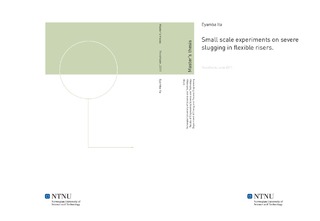Small scale experiments on severe slugging in flexible risers.
Master thesis
Permanent lenke
http://hdl.handle.net/11250/234490Utgivelsesdato
2011Metadata
Vis full innførselSamlinger
Sammendrag
Severe slugging is an undesirable unsteady multiphase flow phenomenon which occurs in riser-pipeline systems. During the course of this masters thesis work, a dynamic coupling has been shown to exist between this flow phenomenon and the flexible riser in which it occurs. To analyse the influence of this coupling, the cyclic displacement of the riser and the loads exerted by this cyclic displacement on the risers attachment point to a topside vessel have been evaluated.A small scale experiment has been set up of a flexible riser (L and S configurations) undergoing the severe slugging cycle. The flexible risers were produced from a flexible transparent hose of internal diameter 0.016 metres and a load cell was used to measure the loads on the riser attachment point to a topside vessel. Three accelerometers were attached along the riser to measure the acceleration of the riser at defined points. The experiment was video recorded and from this, video analysis was used to calculate the displacement of the flexible riser during the severe slugging cycle. Data from the experiments was logged by Catman analysis tool and was compared with numerical simulations from OLGA.Substantial displacement of the flexible riser has been recorded on both configurations of the flexible riser. Displacements in the order of approximately 1 metre have been recorded on some riser points on both riser configurations. When this occurs, there is a cyclic loading on the attachment point of the flexible riser to the topside vessel and this loading in the long term could lead to fatigue of the riser and probable failure. This loading has been illustrated, and maximum and minimum values for both riser configurations have been recorded.For the constructed L-riser, the displacement of the riser at the top, middle and bottom sections were found to be 0.8588, 0.9760 and 0.5856 metres respectively. The maximum and minimum loads on the attachment points of the L-riser to the topside vessel during the severe slugging cycle have been found to be 0.1 and 6.4 Newtons respectively.For the constructed S-riser, the displacement of the riser at the top, middle and bottom section were found to be 0.112, 0.7760 and 0.957 metres respectively. The maximum and minimum loads on the attachment point of the S-riser to the topside vessel during the severe slugging cycle have been found to be 8.0 and 13.6 Newton respectively.
